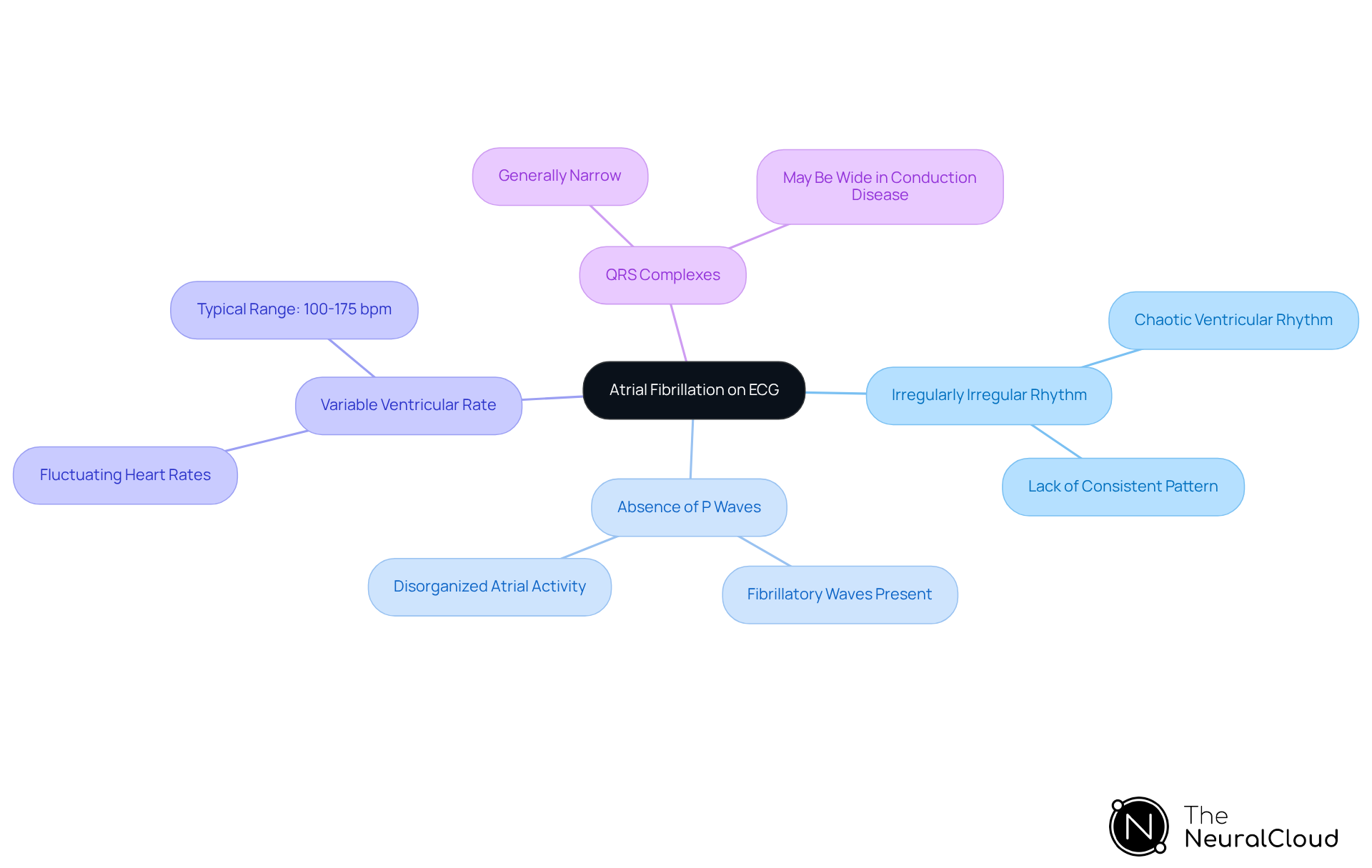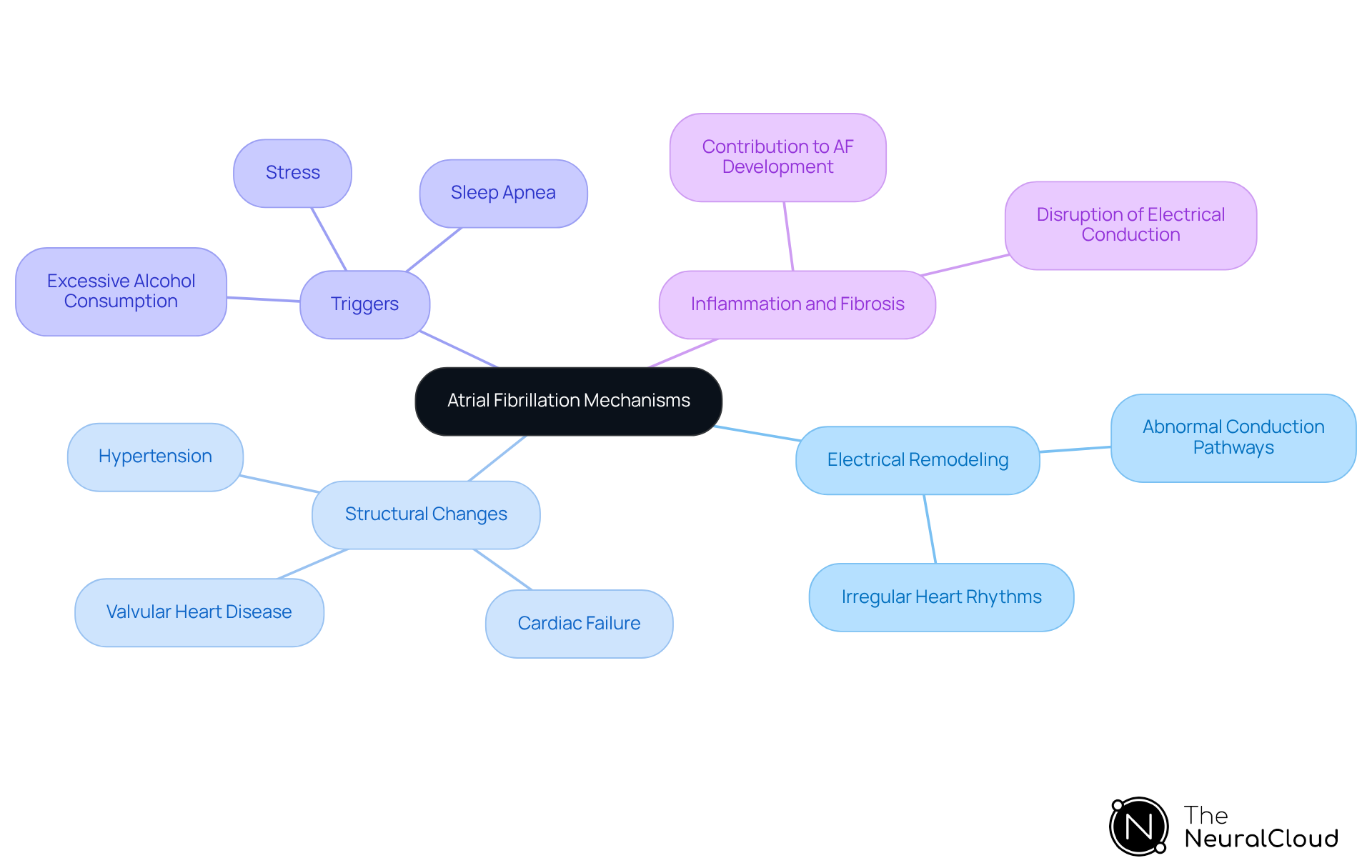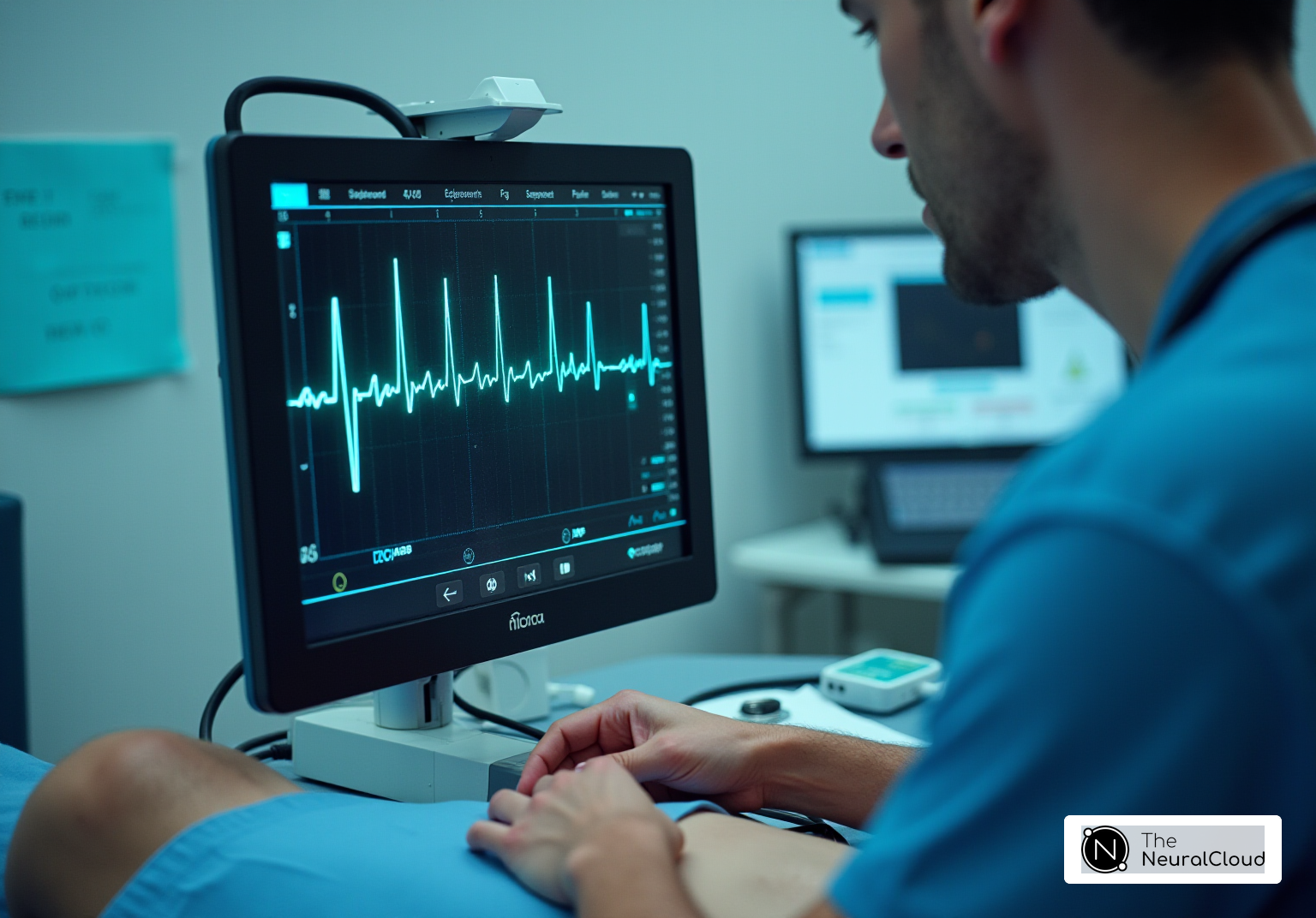Overview
Atrial fibrillation on ECG presents challenges for healthcare professionals, characterized by an irregularly irregular rhythm, the absence of P waves, and variable ventricular rates. Accurate identification of these features is essential for effective management. The MaxYield™ platform addresses these challenges by enhancing the precision of ECG analysis.
Features of the MaxYield™ Platform:
- Advanced diagnostic tools for improved accuracy
- User-friendly interface for efficient analysis
- Real-time data processing for timely interventions
These features provide significant advantages. By utilizing the MaxYield™ platform, healthcare professionals can achieve more accurate ECG interpretations, leading to better patient outcomes. The platform not only streamlines the analysis process but also supports timely decision-making, which is crucial in managing atrial fibrillation effectively.
In conclusion, understanding the key features of atrial fibrillation and leveraging advanced tools like the MaxYield™ platform can significantly enhance ECG analysis. This ultimately leads to improved patient care and outcomes.
Introduction
Atrial fibrillation (AF) poses a significant challenge in cardiovascular health, often leading to severe complications like stroke and heart failure. Its chaotic electrical activity results in an irregular heartbeat, making the accurate identification of AF on an electrocardiogram (ECG) crucial for effective management. This article explores the key features that define AF on ECG, the mechanisms behind its occurrence, and the diagnostic strategies healthcare professionals can employ to enhance patient outcomes.
The MaxYield™ platform offers innovative solutions to improve ECG analysis, addressing the complexities of atrial fibrillation. By leveraging advanced algorithms, the platform enhances the accuracy of AF detection, allowing clinicians to make more informed decisions. This technology not only streamlines the diagnostic process but also reduces the likelihood of misdiagnosis, ultimately leading to better patient care.
The features of the MaxYield™ platform include:
- Real-time data analysis
- User-friendly interfaces
- Comprehensive reporting tools
These advantages empower healthcare professionals to interpret ECG results with greater confidence and efficiency. As a result, clinicians can focus more on patient interaction and less on the intricacies of data interpretation, improving overall workflow and patient outcomes.
In conclusion, advancements in technology like the MaxYield™ platform are transforming the approach to atrial fibrillation diagnosis. By enhancing diagnostic accuracy and providing valuable insights, this platform stands to significantly improve the management of AF, benefiting both healthcare providers and patients alike.
Define Atrial Fibrillation and Its Importance in ECG Analysis
Atrial fibrillation on ECG presents significant challenges in analysis due to its irregular and often rapid rhythm, which can lead to serious complications like stroke and cardiac failure. This condition arises when electrical signals in the atria, the heart's upper chambers, fire chaotically, resulting in an irregular heartbeat. Given its high prevalence among patients with cardiovascular diseases, accurate identification and management of atrial fibrillation on ECG is crucial for healthcare professionals. Early detection of atrial fibrillation on ECG can greatly reduce the risk of severe complications, which highlights the need for effective diagnostic tools.
Neural Cloud Solutions' MaxYield™ platform addresses these challenges by enhancing ECG analysis precision. It effectively maps ECG signals through noise, isolating and identifying critical characteristics in each heartbeat. This platform processes up to 200,000 heartbeats in less than 5 minutes, delivering beat-by-beat analysis that is both rapid and reliable. Its advanced noise reduction capabilities allow for the swift isolation of ECG waves from recordings affected by baseline wander and muscle artifacts, ensuring that essential data is captured even in challenging conditions.
The benefits of using MaxYield™ are substantial for healthcare professionals. By improving diagnostic yield, the platform supports confident clinical decision-making, making it an invaluable resource in managing atrial fibrillation on ECG. With its ability to enhance the accuracy of ECG readings, MaxYield™ not only aids in timely interventions but also contributes to better patient outcomes. This innovative solution empowers healthcare providers to navigate the complexities of AF with greater ease and effectiveness.

Identify Key ECG Features of Atrial Fibrillation
Atrial fibrillation on ECG presents unique challenges in analysis, making accurate identification crucial for effective management. The hallmark features of AF on an ECG include:
- Irregularly Irregular Rhythm: The ventricular rhythm appears chaotic, lacking a consistent pattern.
- Absence of P Waves: Distinct P waves are absent, often replaced by fibrillatory waves, which suggest the presence of atrial fibrillation on ECG due to disorganized atrial activity.
- Variable Ventricular Rate: Heart rates can fluctuate significantly, typically ranging from 100 to 175 beats per minute.
- QRS Complexes: Generally narrow, though they may be wide in cases of pre-existing conduction disease.
Recognizing these characteristics is essential for prompt diagnosis and management of atrial fibrillation on ECG, enabling healthcare providers to initiate appropriate treatment strategies. The MaxYield™ platform enhances ECG analysis capabilities, providing healthcare professionals with tools to accurately identify features of atrial fibrillation on ECG. This leads to improved outcomes for patients, as timely and precise diagnosis is critical in managing AF effectively.

Explore Mechanisms and Causes of Atrial Fibrillation
Atrial fibrillation on ECG can arise from several mechanisms that are crucial for healthcare providers to understand.
-
Electrical Remodeling involves changes in the heart's electrical system, which can create abnormal conduction pathways. This alteration can lead to irregular heart rhythms, making it essential for clinicians to recognize its role in AF.
-
Structural Changes occur due to conditions like hypertension, cardiac failure, and valvular heart disease. These conditions can modify the heart's structure, increasing the likelihood of developing AF. Recognizing these structural changes allows for better risk assessment and management strategies.
-
Triggers such as excessive alcohol consumption, stress, and sleep apnea can provoke episodes of AF. Identifying these triggers is vital for patients, as lifestyle modifications can significantly reduce the frequency of AF episodes.
-
Inflammation and Fibrosis disrupt normal electrical conduction in the atria, contributing to AF development. Understanding these processes helps healthcare providers tailor interventions effectively, especially for patients with atrial fibrillation on ECG.
By comprehending these mechanisms, healthcare professionals can better assess risk factors and implement targeted interventions to prevent AF episodes.

Outline the Diagnostic Approach for Atrial Fibrillation Using ECG
The diagnostic approach for atrial fibrillation (AF) using ECG involves several key steps:
- Individual History and Symptoms: Collect details on the individual's symptoms, medical background, and risk factors for AF.
- ECG Acquisition: Perform a 12-lead ECG to capture the heart's electrical activity. Ensure the patient is at rest to minimize artifacts.
- ECG Interpretation: Examine the ECG for essential characteristics of AF, such as the absence of P waves and irregular ventricular rhythm. Advanced platforms like MaxYield™ streamline this process by rapidly labeling P, QRS, and T Wave onsets and offsets, providing automated analysis that enhances diagnostic accuracy.
- Continuous Monitoring: If AF is suspected but not captured on a single ECG, consider using Holter monitors or event recorders for extended monitoring. Neural network models developed by Neural Cloud Solutions can support this by processing complex signal inputs and extracting key features from the data.
- Further Testing: Depending on the findings, additional tests such as echocardiography may be warranted to assess structural heart disease. MaxYield™ not only enables users to analyze more data in less time but also aids in discovering new digital biomarkers, providing actionable insights for improved patient outcomes.

Conclusion
Atrial fibrillation presents significant challenges in ECG interpretation due to its irregular rhythm and potential for severe complications. Accurately identifying and managing atrial fibrillation on ECG is crucial for healthcare professionals, as early detection can significantly reduce associated risks. The MaxYield™ platform from Neural Cloud Solutions enhances ECG analysis precision, allowing clinicians to navigate the complexities of atrial fibrillation with increased confidence.
Key features of atrial fibrillation on ECG include:
- An irregularly irregular rhythm
- The absence of distinct P waves
- Variable ventricular rates
Understanding these characteristics, along with the underlying mechanisms and causes of atrial fibrillation, empowers healthcare providers to implement effective management strategies. A comprehensive diagnostic approach, from individual history to continuous monitoring, ensures timely interventions that can improve patient outcomes.
Recognizing the significance of atrial fibrillation in cardiovascular health is essential for both healthcare professionals and patients. By prioritizing accurate diagnosis and utilizing innovative tools like the MaxYield™ platform for ECG analysis, clinical decision-making can be enhanced, leading to better health outcomes. Emphasizing awareness and education around atrial fibrillation fosters proactive measures in prevention and management, highlighting the need to address this prevalent condition in the healthcare landscape.
Frequently Asked Questions
What is atrial fibrillation and why is it important in ECG analysis?
Atrial fibrillation is a condition characterized by an irregular and often rapid heartbeat due to chaotic electrical signals in the atria, the heart's upper chambers. It is important in ECG analysis because it can lead to serious complications like stroke and cardiac failure, making accurate identification and management crucial for healthcare professionals.
How does atrial fibrillation affect ECG readings?
Atrial fibrillation presents significant challenges in ECG analysis due to its irregular rhythm, which complicates the interpretation of heartbeats and increases the risk of misdiagnosis.
What role does early detection of atrial fibrillation play?
Early detection of atrial fibrillation on ECG can significantly reduce the risk of severe complications, highlighting the need for effective diagnostic tools in healthcare.
What is Neural Cloud Solutions' MaxYield™ platform?
MaxYield™ is a platform designed to enhance ECG analysis precision by effectively mapping ECG signals, isolating critical characteristics in each heartbeat, and processing large volumes of heartbeats rapidly.
How quickly can the MaxYield™ platform process ECG data?
The MaxYield™ platform can process up to 200,000 heartbeats in less than 5 minutes, providing beat-by-beat analysis that is both rapid and reliable.
What are the benefits of using the MaxYield™ platform for healthcare professionals?
The MaxYield™ platform improves diagnostic yield, supports confident clinical decision-making, enhances the accuracy of ECG readings, and contributes to better patient outcomes in managing atrial fibrillation.
How does MaxYield™ handle challenges in ECG recordings?
MaxYield™ has advanced noise reduction capabilities that allow it to isolate ECG waves from recordings affected by baseline wander and muscle artifacts, ensuring essential data is captured even in challenging conditions.






